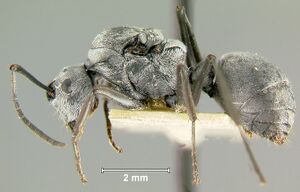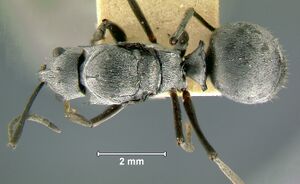Polyrhachis diana
| Polyrhachis diana | |
|---|---|

| |
| Scientific classification | |
| Kingdom: | Animalia |
| Phylum: | Arthropoda |
| Class: | Insecta |
| Order: | Hymenoptera |
| Family: | Formicidae |
| Subfamily: | Formicinae |
| Tribe: | Camponotini |
| Genus: | Polyrhachis |
| Subgenus: | Myrma |
| Species group: | aculeata |
| Species complex: | pubescens |
| Species: | P. diana |
| Binomial name | |
| Polyrhachis diana Wheeler, W.M., 1909 | |
Identification
A member of the Polyrhachis aculeata species group in the subgenus Myrma
Kohout (2013): When describing P. diana, Wheeler (1909) noted it was closely related to Polyrhachis latona, described from Taiwan in the same paper. He listed the more abundant and silvery pubescence, shorter thorax and the different shape of the petiole and its associated spines as characters distinguishing P. diana from P. latona. In addition to these characters, P. diana also differs from P. latona by its more distinct sculpturation of the head and mesosoma, more convex eyes, notably when viewed from behind, and transversely broader petiolar node, which lacks the intercalary tooth that is rather prominent in P. latona. Polyrhachis diana is also similar to Polyrhachis murina Emery, a species originally described from Borneo and the Philippines. Polyrhachis murina differs by its distinctly shorter pronotal spines, much finer sculpturation of the mesosomal dorsum and by having the lateral petiolar teeth extended into short spines.
Keys including this Species
Distribution
Distribution based on Regional Taxon Lists
Indo-Australian Region: Philippines (type locality).
Distribution based on AntMaps
Distribution based on AntWeb specimens
Check data from AntWeb
Countries Occupied
| Number of countries occupied by this species based on AntWiki Regional Taxon Lists. In general, fewer countries occupied indicates a narrower range, while more countries indicates a more widespread species. |

|
Estimated Abundance
| Relative abundance based on number of AntMaps records per species (this species within the purple bar). Fewer records (to the left) indicates a less abundant/encountered species while more records (to the right) indicates more abundant/encountered species. |

|
Biology
Castes
- Queen
   
| |
| . | Owned by Museum of Comparative Zoology. |
Males and immature stages unknown.
Nomenclature
The following information is derived from Barry Bolton's Online Catalogue of the Ants of the World.
- diana. Polyrhachis diana Wheeler, W.M. 1909d: 343 (w.) PHILIPPINES. Combination in P. (Myrma): Emery, 1925b: 201.
Description
Worker
Kohout (2013) - Dimensions (syntypes cited first): TL c. 6.35-7.16, 6.35-7.16; HL 1.65-1.72, 1.65-1.72; HW 1.25-1.31, 1.25-1.34; CI 76-77, 76-80; SL 2.06-2.18, 2.06-2.18; SI 161-167, 160-167; PW 1.28-1.31, 1.28-1.31; MTL 2.03-2.12, 2.03-2.12 (5+2 measured).
Type Material
- Syntype, workers, MINDANAO, Butuan, Philippines, 19.xii.1907, H.M. Smith, Co-type 22958, American Museum of Natural History, Museum of Comparative Zoology.
References
- Kohout, R. J. 2013. A review of the Polyrhacis aculeata species-group of the subgenus Myrma Billberg (Hymenoptera: Formicidae), with keys and descriptions of new species. Australian Entomologist. 40:137-171.
- Baltazar, C.R. 1966. A catalogue of Philippine Hymenoptera (with a bibliography, 1758-1963). Pacific Insects Monographs 8: 1-488. (page 276, listed)
- Emery, C. 1925d. Hymenoptera. Fam. Formicidae. Subfam. Formicinae. Genera Insectorum 183: 1-302 (page 201, Combination in P. (Myrma))
- Wheeler, W. M. 1909d. Ants of Formosa and the Philippines. Bull. Am. Mus. Nat. Hist. 26: 333-345 (page 343, worker described)
- Wong, T.L., Guénard, B. 2020. Review of ants from the genus Polyrhachis Smith (Hymenoptera: Formicidae: Formicinae) in Hong Kong and Macau, with notes on their natural history. Asian Myrmecology 13: e013001 (doi:10.20362/am.013001).
References based on Global Ant Biodiversity Informatics
- Kohout R. J. 2013. A review of the Polyrhachis aculeata species-group of the subgenus Myrma Billberg (Hymenoptera: Formicidae: Formicinae), with keys and descriptions of new species. Australian Entomologist 40(3): 137-171.
- Robson Simon Database Polyrhachis -05 Sept 2014
- Wheeler W. M. 1909. Ants of Formosa and the Philippines. Bulletin of the American Museum of Natural History 26: 333-345.

